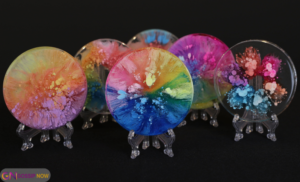A petri dish is a fundamental tool in the world of microbiology, often used for growing cultures of microorganisms like bacteria, fungi, and algae. It’s a shallow, flat, lidded dish typically made of glass or clear plastic. Petri_dishes commonly associate with scientific labs, but their applications extend far beyond the lab bench. If you’ve ever wondered what a petri dish is used for, this article explores its many uses, explains how it works, and highlights its significance in scientific research.
What is a Petri Dish? – Petri Dish Definition

A petri_dish is a small, round, shallow, flat-bottomed dish with a matching lid, often used in laboratory settings. Petri_dishes commonly culture microorganisms, but they also serve various other purposes across different scientific fields. You can fill the surface of the dish with an agar medium, which provides a nutrient-rich environment for bacteria, fungi, and other microorganisms to grow.
In essence, petri_dishes act as a controlled environment that mimics real-world conditions for the growth of microorganisms, making them indispensable in fields like microbiology, biochemistry, and medical research.
Types of Petri Dishes
Various types of petri_dishes exist to meet specific needs. The most common types include:
-
Agar Petri Dish: This petri dish fills with agar, a gelatinous substance derived from seaweed, which provides the growth medium for microorganisms.
-
Plastic Petri Dish: People typically use these disposable dishes for general-purpose microbiological work. Schools and research settings often prefer them due to the ease of disposal.
-
Glass Petri Dish: Researchers can reuse glass dishes and sterilize them, making them a more environmentally friendly choice for long-term research.
Each petri_dish type has a specific application based on its material and whether it contains agar or another medium.
Petri Dish Uses: What Is a Petri Dish Used For?
Petri_dishes have a variety of uses, primarily in scientific and educational fields. The following are some of the most common applications:
1. Culturing Bacteria and Fungi
Petri_dishes commonly grow cultures of bacteria, fungi, and other microorganisms in microbiology. When a scientist or student wants to examine a sample of bacteria, they can place it on an agar-filled petri_dish. The bacteria then multiply, forming visible colonies.
2. Studying Mold Growth
Another fascinating application of petri_dishes is observing the growth of mold.Mold thrives on organic materials, and scientists often use petri_dishes to study different types of mold and their growth patterns. Glass petri_dishes are reusable and can withstand sterilization, making them more environmentally friendly for long-term research.
This can be particularly useful in understanding mold infestations in food or homes. For instance, black mold in petri_dish experiments can help researchers understand the environmental conditions that promote mold growth.
3. Seed Germination Studies
In plant biology, petri_dishes are frequently used to study seed germination. Thanks to the controlled environment provided by the petri_dish, researchers can closely monitor how seeds sprout and grow over time. As a result, these dishes become invaluable tools for experiments that observe plant growth under various conditions.
4. Antibiotic Testing
In addition, petri_dishes serve as essential tools in testing the efficacy of antibiotics. By placing bacteria on the dish and exposing them to different substances, researchers can carefully observe how effectively each antibiotic combats bacterial growth. Consequently, petri_dishes help identify the most effective antibiotics for combating specific bacterial strains.
5. Cell Culture and Tissue Engineering
Similarly, in biotechnology and medicine, researchers use petri_dishes to culture animal and human cells. This enables researchers to study cell behavior, test various drugs, and even grow tissues for medical purposes. Moreover, petri_dishes provide the ideal environment for cultivating cells, which is crucial for advancements in medical treatments.
Petri Dish with Agar: How It Works
The agar medium inside a petri_dish serves as the foundation for microbial growth. Agar is a gelatinous substance that stays solid at room temperature, providing nutrients while maintaining a stable surface for organisms to grow. Researchers often prepare agar petri dishes with specific nutrients to support the growth of particular microorganisms.
When you introduce microorganisms to a petri_dish with agar, they feed on the nutrients and form visible colonies. This system allows scientists to isolate different types of microorganisms and study them in detail.
Black Mold in Petri Dish: What It Tells Us
Scientists can grow mold, including black mold, on petri_dishes under controlled conditions to study its behavior and growth rate. Petri_dishes offer an excellent medium for observing how mold spreads and interacts with various environments. For example, black mold thrives in moisture-rich environments, so petri_dish studies can reveal the ideal conditions for its growth.
Selecting the Right Petri Dish for Your Needs
 When you choose a petri_dish, consider the type of experiment you’re conducting. If you’re working with microorganisms, select an agar petri_dish, as agar provides the nutrients needed for growth. If you’re observing mold growth, opt for a high-quality plastic or glass dish that you can easily clean and reuse.
When you choose a petri_dish, consider the type of experiment you’re conducting. If you’re working with microorganisms, select an agar petri_dish, as agar provides the nutrients needed for growth. If you’re observing mold growth, opt for a high-quality plastic or glass dish that you can easily clean and reuse.
Key Factors to Consider:
-
Material: Glass or plastic?
-
Size: Standard 90mm or larger for more growth space?
-
Sterilization: Disposable or reusable options?
-
Type of Medium: Agar or specialized nutrient agar?
Conclusion
The petri_dish is an indispensable tool in scientific research, providing a controlled environment to study microorganisms, fungi, bacteria, and even mold. Whether used in microbiology, medicine, or plant biology, the petri_dish plays a crucial role in advancing scientific knowledge. From agar petri_dishes for growing bacteria to studying black mold in petri_dishes, this humble laboratory tool is essential for hands-on experimentation and discovery.
By understanding its definition, types, and applications, you can appreciate the versatility of the petri_dish in scientific exploration. With the right knowledge and equipment, petri_dishes continue to be invaluable in unlocking the mysteries of the microbial world.
FAQs
1. What is a petri dish made of?
A petri_dish is typically made from glass or clear plastic, with some varieties made from biodegradable materials.
2. How do you use a petri dish in the lab?
Petri_dishes are used in labs to culture microorganisms, grow bacteria, fungi, and mold, and study cell cultures under controlled conditions.
3. Why do scientists use agar in petri dishes?
Agar serves as a nutrient-rich medium that supports the growth of microorganisms, providing them with essential nutrients to thrive.
4. Can petri dishes grow mold?
Yes, petri_dishes are commonly used to grow mold, allowing researchers to study its growth patterns and behavior in a controlled environment.
5. How do you prevent contamination in petri dishes?
To prevent contamination, petri_dishes should be sterilized before use, and proper techniques such as aseptic handling should be followed.






